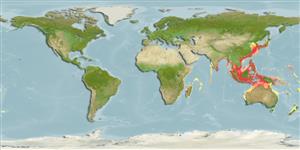Common names from other countries
Environment: milieu / climate zone / depth range / distribution range
Écologie
; profondeur 2 - 219 m (Ref. 409). Tropical (Ref. 8)
Distribution
Pays | Zones FAO | Écosystèmes | Occurrences | Introductions
Indo-West Pacific: from Japan to Indonesia and Malaya.
Length at first maturity / Taille / Poids / Âge
Maturity: Lm ? range ? - ? cm Max length : 10.8 cm TL mâle / non sexé; (Ref. 8)
Inhabits sand, mud or sandy-mud bottoms from depths of 2-219 m, usually at less than 90 m (Ref. 409).
Life cycle and mating behavior
Maturité | Reproduction | Frai | Œufs | Fécondité | Larves
Members of the order Decapoda are mostly gonochoric. Mating behavior: Precopulatory courtship ritual is common (through olfactory and tactile cues); usually indirect sperm transfer.
Holthuis, L.B. 1980. (Ref. 8)
Statut dans la liste rouge de l'IUCN (Ref. 130435)
statut CITES (Ref. 108899)
Not Evaluated
Not Evaluated
Utilisations par l'homme
Pêcheries: commercial
| FishSource |
Outils
Sources Internet
Estimates based on models
Preferred temperature
(Ref.
115969): 16.6 - 28.5, mean 27.1 (based on 1024 cells).
Résilience
Haut, temps minimum de doublement de population inférieur à 15 mois (K=1.14-1.94).
Vulnérabilité
Low vulnerability (10 of 100).
